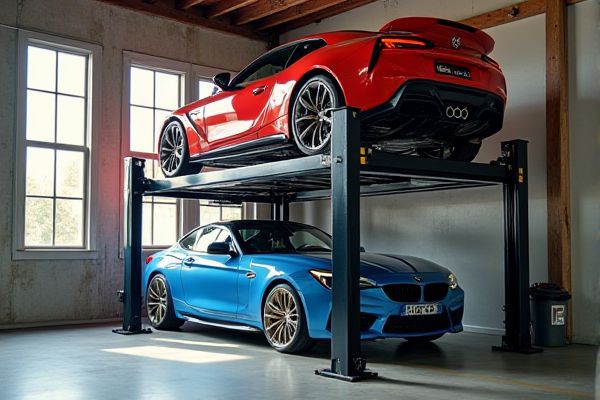
A vehicle lift offers vertical space savings by raising cars to different levels, ideal for automotive workshops and garages, while a parking stacker maximizes parking capacity in limited spaces by stacking vehicles directly above each other for efficient storage. Discover how each option can enhance your parking or maintenance setup by reading the rest of this article.
Table of Comparison
| Feature | Vehicle Lift | Parking Stacker |
|---|---|---|
| Purpose | Lifts vehicles vertically for maintenance or storage | Maximizes parking space by stacking vehicles |
| Capacity | Typically supports 5,000 - 15,000 lbs | Supports standard passenger vehicles, up to around 6,000 lbs per level |
| Installation | Requires garage or workshop, fixed installation | Installed in parking garages or lots, can be modular |
| Operation | Hydraulic or electric lifting mechanism | Automated or semi-automated stacking system |
| Space Efficiency | Saves vertical space during vehicle maintenance | Maximizes parking density by stacking vehicles vertically |
| Use Cases | Auto repair shops, personal garages | Commercial parking lots, urban areas with limited parking |
| Cost | Moderate, depending on capacity and features | Higher initial investment due to automation and complexity |
| Safety | Standard safety locks and sensors | Advanced safety protocols for vehicle stacking and retrieval |
Understanding Vehicle Lifts and Parking Stackers
Vehicle lifts are mechanical systems designed to vertically elevate cars for maintenance or storage, optimizing space in garages or workshops. Parking stackers efficiently multiply parking capacity by stacking vehicles vertically, making them ideal for urban areas with limited ground space. Both systems enhance space utilization but serve distinct purposes: vehicle lifts primarily aid in vehicle servicing, while parking stackers focus on maximizing parking availability.
Key Differences Between Vehicle Lifts and Parking Stackers
Vehicle lifts primarily serve to raise vehicles vertically within garages or workshops for maintenance and repair, offering easy access to the underside of your car, while parking stackers maximize parking space by stacking vehicles vertically in residential or commercial parking areas. Vehicle lifts typically support heavier weights and provide adjustable height settings, whereas parking stackers focus on efficient space utilization, often featuring automated or semi-automated mechanisms for vehicle placement. Choosing between the two depends on whether your priority is vehicle servicing efficiency or optimizing limited parking space.
Space Efficiency: Which Option Saves More Room?
Vehicle lifts provide vertical parking solutions that significantly increase space efficiency by stacking cars one above the other, maximizing the use of limited floor area. Parking stackers also optimize space but may require more horizontal clearance due to their platform designs and movement mechanics. Your choice depends on available ceiling height and layout constraints, with vehicle lifts typically offering superior room-saving benefits in tighter spaces.
Installation and Maintenance Requirements
Vehicle lifts generally require more extensive installation, including reinforced flooring and electrical wiring to support heavy loads and ensure safety compliance, while parking stackers can often be installed with less structural modification due to their modular design. Maintenance for vehicle lifts involves regular inspections of hydraulic systems, cables, and safety locks to prevent mechanical failures, whereas parking stackers demand routine checks on motorized platforms and locking mechanisms to guarantee smooth operation and prevent vehicle damage. Both systems benefit from professional servicing, but vehicle lifts typically incur higher maintenance costs due to their complex mechanical components.
Safety Features and Considerations
Vehicle lifts typically include safety locks, overload sensors, and emergency stop mechanisms to prevent accidents during vehicle elevation. Parking stackers incorporate sturdy platforms with anti-slip surfaces and automated braking systems to secure vehicles in multi-level parking setups. Both systems require regular maintenance and adherence to manufacturer guidelines to ensure optimal safety performance.
Cost Comparison: Upfront and Long-Term Expenses
Vehicle lifts generally require a higher upfront investment due to complex installation and robust mechanical components, while parking stackers offer a more cost-effective initial purchase with simpler setup. Over the long term, vehicle lifts may incur higher maintenance expenses but provide greater durability and load capacity, making them suitable for heavy-duty use. Parking stackers, although cheaper to maintain, can lead to higher operational costs in dense parking environments due to limited scalability and slower vehicle retrieval times.
Vehicle Compatibility and Capacity Limits
Vehicle lifts are designed to accommodate a broader range of vehicle sizes and weights, often supporting heavier cars, SUVs, and trucks up to several tons. Parking stackers typically have more restrictive capacity limits, best suited for compact and mid-sized vehicles due to their structural design. Understanding your vehicle's dimensions and weight is essential to ensure compatibility and safe operation within the specified limits of either system.
Ideal Use Cases for Vehicle Lifts
Vehicle lifts are ideal for automotive workshops, garages, and service centers requiring easy access to the vehicle's undercarriage for repairs, maintenance, and inspections. They are well-suited for environments with limited vertical space but ample horizontal room, enabling technicians to work comfortably on a single vehicle at a time. Vehicle lifts provide precise elevation control, making them essential for detailed mechanical work and safety inspections.
Best Applications for Parking Stackers
Parking stackers are ideal for maximizing space in compact urban garages, residential buildings, and commercial parking lots where vertical storage is essential. They efficiently double or triple parking capacity by stacking vehicles securely, making them perfect for locations with limited floor area but ample ceiling height. Your facility benefits from improved space utilization and easier vehicle organization without extensive structural modifications.
Making the Right Choice for Your Parking Needs
Vehicle lifts offer vertical space-saving solutions ideal for residential garages or small commercial spaces, providing easy access and efficient car storage. Parking stackers maximize capacity by allowing multiple vehicles to be parked in a single footprint, perfect for high-density areas or urban environments with limited ground space. Choosing between a vehicle lift and a parking stacker depends on factors like available ceiling height, vehicle size, frequency of use, and overall parking demand.
 homyna.com
homyna.com